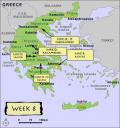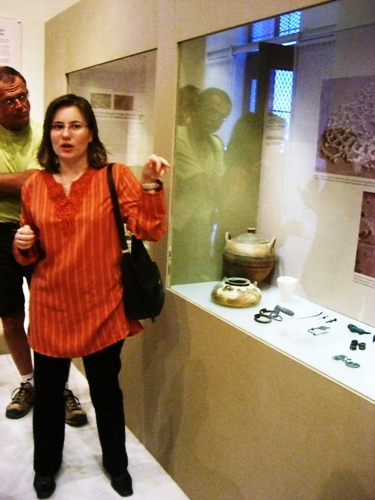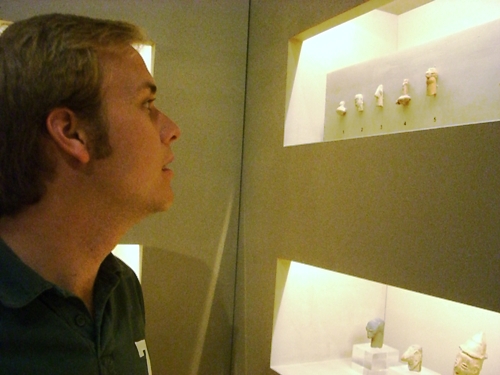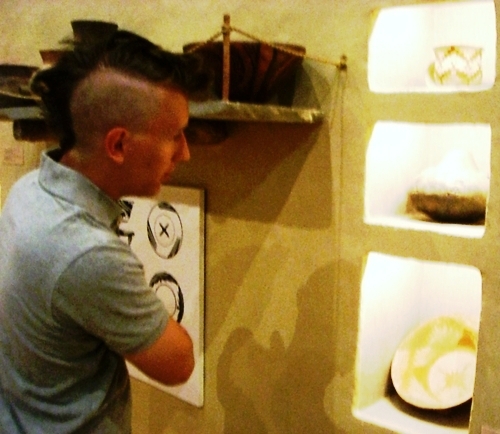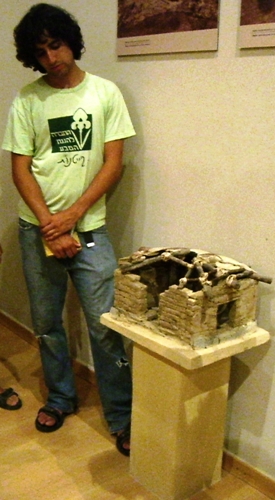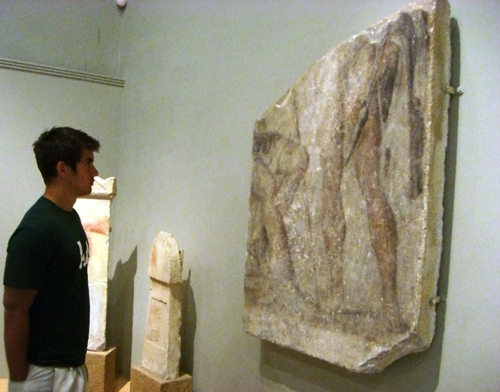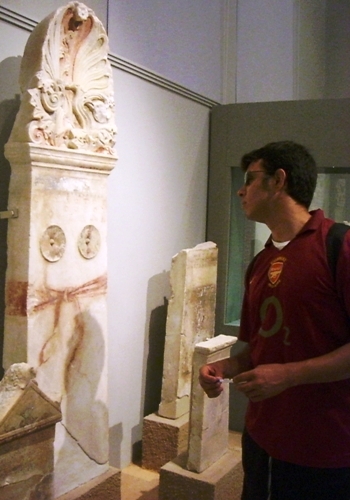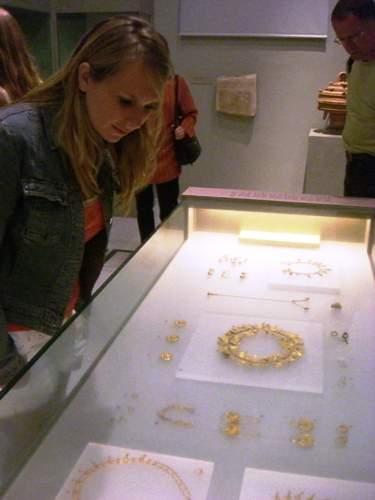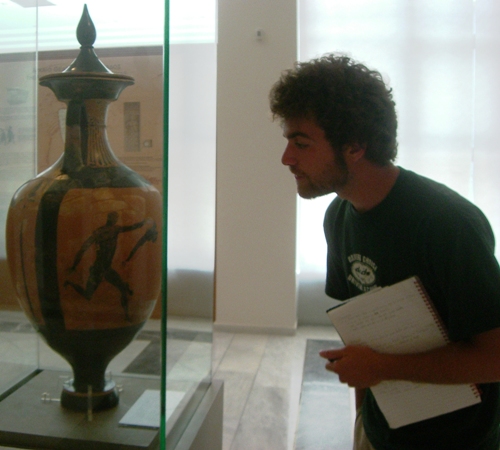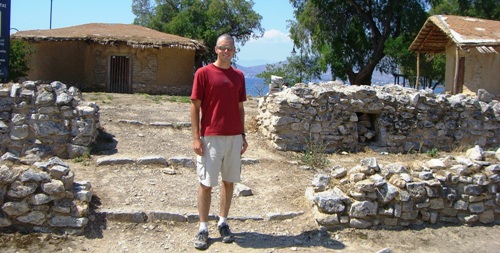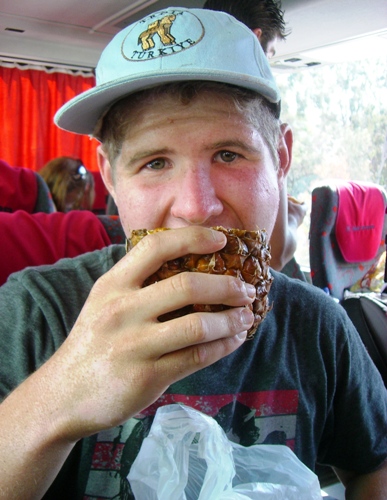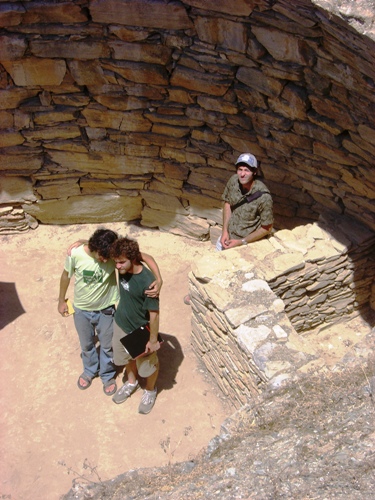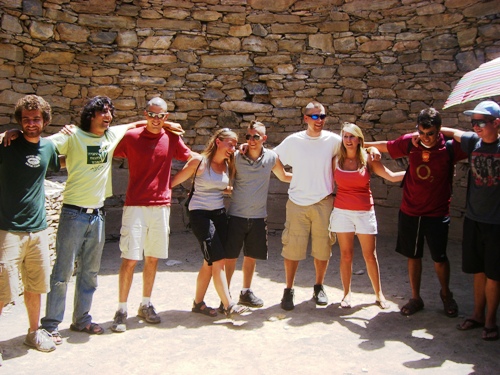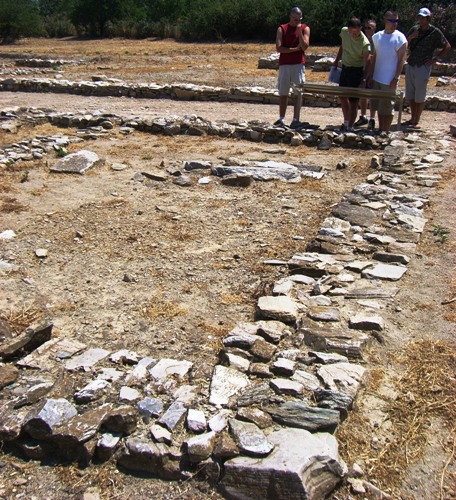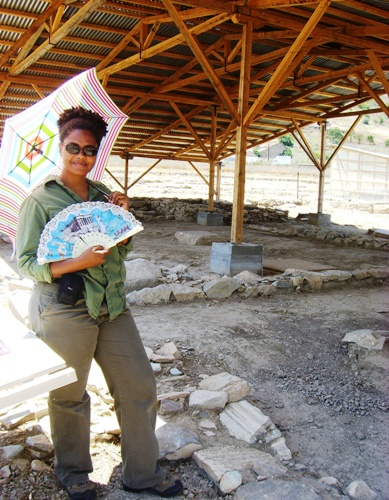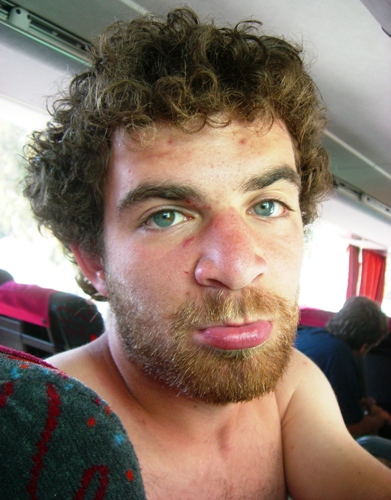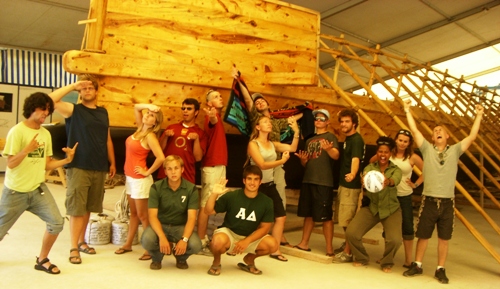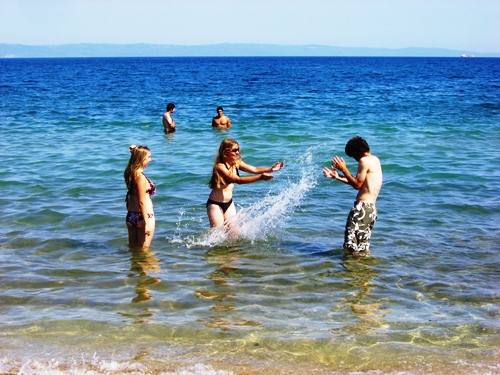Date: May 13
Partners for the day: Kinsey Stewart (text) Liz Stamoulis (images)
Site(s): Dimini
Museum(s): Volos Museum, Pefkakia
Principal Buildings/Monuments: Neolithic acropolis at Dimini, Mycenean tholos tomb, propylon, reconstructed Argo
Time Spent on Each Site: from ca. 10:15 AM to ca.3:00 PM [ 5 hours]
Weather: Sunny and hot
If there is one thing that we have learned after almost three months of Greek radio and dance clubs, the one thing Europeans love more than a good football match (“soccer” to us barbarian Americans) is a kitschy pop song. Much to our amusement and occasional bafflement, this need for catchy dance music occasionally results in the re-recording and re-mixing of decidedly non-dance hits from American artists such as Radiohead and Nickleback in order to give them throbbing techno beats suitable for discos and blasting out of car windows at all hours.
The latest manifestation of this desire to dance, dance, revolution that we have experienced has been the Eurovision Song Contest, an annual competition for over 50 years in which the various countries of Europe compete in an internationally-broadcast event reminiscent of the ancient contests in lyric poetry and song. Each country sends a representative artist singing a previously unreleased song, and viewers of the program call in to vote for their favorites. Over the past few days of the contest’s airing, our T.A. Caleb, who knows of the joy that is Eurovision thanks to his previous travels in Greece, has been slowly luring us one-by-one into its oddly hypnotizing spectacle. The live broadcast of last night’s finals found us all—including Prof. Rutter—clustered around the tiny televisions in our hotel rooms, straining to hear the English commentators under the Greek dubbing and watching agog at the often-ridiculous but entirely entertaining display. While it may sound like an over-vamped version of American Idol, the political and musical controversy that often surrounds the contest and voting makes for a show entirely unlike anything that graces TV sets back in the USA. For all of Simon Cowell’s biting commentary, America’s favorite amateur singing competition has yet to result in effigies of Ukrainian drag-queens (draped in fur-lined silver finery and sporting a gilded, star-shaped headdress) being burned in Russia because of a miss-pronounced song lyric in Mongolian.
Though the contest entries span the musical range from traditional folk music to neo-gothic glam-rock, European pop (most often sung in English) remains the musical style of choice for the professional and amateur artists involved in the contest. Still, across the board the general consensus seems to be that the best way to cover up any musical short-comings is with a flashy performance featuring elaborate staging, pyrotechnics, and scantily-clad background dancers sporting chain mail and swords. Eurovision may claim to be a music competition, but with the visual element of television thrown into the mix, the impact of such background accessories on the voting audience cannot be ignored.
Similarly, the visual element in museum design also cannot be ignored. It may seem odd to compare intentionally gaudy popular entertainment with institutions whose primary purpose lies in the display and dispensing of more academically-minded information, but while museums may lack the smoke machines and world-wide television audience of the Eurovision Song Contest, the trend in modern museum design has been to engage the visitor with the artifacts in the same way that a performer engages his audience, drawing them into the performance through a variety of sensory media. In anticipation of increased tourism thanks to the 2004 Olympics, the Greek government and the EU made available funding for museums wishing to update their display spaces. Thus, many of the museums we have visited during the course of our travels have taken steps away from the traditional 19th and early 20th century museum model of rows of minimally-signed artifacts on shelves and towards more interactive spaces.
Even within this more modern museum context, the museum at Volos, our first stop today, is exceptional in its presentation of artifacts to the visitor. Generally, even the most radically designed museums feature glass cases of some sort, but the majority of the artifacts at the Volos Museum are displayed out in the open, inviting the visitor to come close enough to almost touch history. The gallery space is also laid out in such a way as to invoke a feeling of the artifacts displayed within their native archeological context. In one room a massive earth cross-section shows the various stratified levels of a site. In another reproduced burials—grave goods and skeletal remains included—are arranged chronologically in a way entirely unique amongst museums in Greece.
In order for such exhibits to be effective, however, there must be some substance behind the spectacle. There is a balance between the academic merit of a museum and the visual entertainment of its design that must be maintained. While innovative in design, the Volos Museum is not over-the-top, and it is built around a collection of high-quality artifacts such as its collection of painted grave stelai. A museum without content is not an effective museum, for it does not fulfill its main function of informing the visitor. An example of this can be found in the display space of the reconstructed Argo—the mythic ship sailed by Jason and the Argonauts—at Pefkakia. The spaces relies entirely upon the impression created by such a massive prop piece. Beyond photographs and a few tools showing the construction of the 1:1 model, there is little actual information on the function of the ship in myth and antiquity, the basis for the design of the reconstruction, or any new insight into ancient boat-making acquired during its construction. The boat certainly looks very nice, and I can only imagine what it would look like in the water, but it remains less a museum and more of a road-side tourist attraction, a mediocre pop song that receives a lot of attention because of the special effects utilized in the music video and the costume (or lack their of) of the background dancers.
Despite the music industry’s notoriously plastic emphasis much of the time, at last night’s Eurovision finals the same held true. Certainly a number of visual-focused acts did well in the contest: the aforementioned Ukrainian drag queen placed second, and a Russian group of three very attractive women who sang a very average song in a very average way placed in the top five, faring far better than more talented groups with less talented bone structure. But it was Serbia, whose relatively simplistic performance was far from visually stunning (an unassuming, androgynously-dressed female singer backed by a small female chorus moving pensively through simple choreography), who won the contest thanks to the universally-recognized power and range of Marija Serifovic’s voice. Like a good museum space, she was able to convey the content and intent of her song to the audience despite being the first artist in several decades to win the contest with a song that contains no English lyrics, proof that with the proper design and execution, ideas and information can transcend linguistic and cultural boundaries.
Welcome, ladies and gentlemen, to Archaeo-Vision 2007! As you may know, this is a contest that will decide which site in the area of Volos puts on the best show. Our first contestant is the Volos Museum. In the first room, our guest judge, Dimitra Rousioti, points out how well they display offerings from the Halos tomb. Ms. Rousioti joins us as Greek archaeologist and a former excavator at the site at Dimini. Professor Jeremy Rutter of Dartmouth College, the leader of the Classics Foreign Study Program to Greece, observes the vases and the bronze and iron artifacts dating from the 15th to 8th centuries BCE.
Caleb is impressed not only by the Neolithic figurines, but also by the fact that, unlike most other museums, the Volos Museum does not place most of their artifacts behind glass. Extra points will be awarded for making the objects more easily accessible to viewers. This concept was pioneered in Greece by Mr. Chourmouziadis, after whom the room exhibiting the Neolithic finds from Thessaly is named. The figurines generally depict women, with the sexual characteristics of the figures exaggerated.
Pete is amazed by the museum’s collection of Neolithic pottery. They are elaborately decorated with complicated patterns made with paint and incisions. The decoration on this pottery shows connections with the Cyclades and the Balkans. The Volos Museum is known for having well-preserved objects that represent various aspects of the Neolothic era.
Across the way, Gahl observes the reconstruction of a Neolithic house. Constructed out of straw, clay, and wood, this is a building type that was popular in Thessaly as recently as the 1950’s, when an earthquake devastated the area. Gahl is impressed that the museum’s presentation shows remains from all aspects of Neolithic life, and that it relates the Neolithic past to the present era.
“This museum is really pulling out all the stops!” Nick exclaims as he studies the painted Hellenistic grave stele. This is another of the Volos Museum’s highlights, the exhibitions of the stelai from the site of Demetrias. They are exceptionally well preserved because they were built into a later Hellenistic fortification wall. Because they give us good evidence for the appearance of Hellenistic free painting, of which there is little preserved, the Volos Museum is sure to perform well in the competition.
Johann especially likes this Hellenistic grave stele with a painted red band and two rosettes in relief. These types of monuments are known to us mainly from their depiction on white-ground lekythoi. The painted band represents the red sashes that would have been tied around the grave monuments.
Kelsey is drawn to the beautiful display of jewelry from various ocations, mainly around Larissa. These artifacts date from the Geometric through the Hellenistic periods and would have been placed along with burials inside of tombs.
Kristina, Professor Rutter, and Johann observe the way the Volos Museum displays different forms of burial from various periods in one room. The viewer is encouraged to walk around the perimeter to observe the ways in which burials changed over time. Immediately in front of them is the reconstruction of a Geometric grave excavated in Thessaly. Just behind them is the reconstruction of a Late Bronze Age cist grave, and in the far back is the reconstruction of a Middle Bronze Age cist grave.
In the last room of the museum, Ray checks out a red-figure Panathenaic amphora. This has a depiction of a running race on one side, for which the vase would have been awarded to the winner as one of many filled with olive oil. This exhibition room with artifacts associated with athletics was created in honor of the 2004 Summer Olympics held in Athens.
The Volos Museum caps off its presentation with two life-sized reconstructions of Neolithic buildings located across the street. One is reconstructed as a kiln in which pottery would have been fired. In the other, replicas of artifacts from the museum were used to recreate a Neolithic house. Next we’ll take a look at our second contestant, after this commercial break.
Traveling around to archaeological sites can sure make you hungry. Sometimes you want something sweet, but you don’t want to undo all that exercise you’ve been doing with a calorie-loaded, unhealthy chocolate bar. If this sounds like you, you should try Kyle’s Pineapples! They’re naturally sweet and are good sources of manganese, Vitamin C, and Vitamin B1. Pineapples aren’t only great to eat, they’re great for you! (Disclaimer: Eating large amounts of pineapple can cause a tingling sensation in your tongue, and in rare cases cuts on the top of the mouth.)
Welcome back to Archaeo-Vision 2007! Next up is Dimini. Brooks admires the central courtyard of the Neolithic construction, defined by the first two of six low enclosure walls. The exact function of the court is unknown, although it was the center of the settlement’s activities and could have been a megaron or a temple. Dimini makes good use of its gorgeous view, for from the central court the sites of Palaia and Volos can be seen. These two locations, together with Dimini, make a triangle of Mycenaean settlements in the area.
Dimini is putting their best foot forward by exhibiting one of their two Mycenaean tholos tombs, located northwest of the Neolithic area of the site. As part of their presentation, they re-enact the mourning over the dead body. Ben stands solemnly at the side of the stone construction in which the body would have been placed, while Gahl and Ray mourn over the deceased Mycenaean.
The judges are so moved by the Mycenaean tholos tomb that they give a rousing rendition of “Give Peace a Chance” in honor of the deceased Mycenaean and also to commemorate the last tholos tomb they will see on their travels. Dimini is certainly having a profound impact on them.
Mike, Professor Rutter, Pete, Josh, and Ben inspect the remains of a building located along the main street of the Mycenaean settlement around the Neolithic acropolis. The combination of Neolithic and Mycenaean remains will definitely help Dimini’s performance in the competition.
In order to win more votes, Dimini is trying to cash in on its claim of being the original site of Iolkos, the legendary location from which Jason and the Argonauts set off on their quest. The actual modern-day location of this site is unknown, and many others, including Pefkakia, have claimed its name. “Get over here, fleece!” Nick as Jason says to Ray and Gahl as the Golden Fleece.
Dimini’s finale is the Propylon leading into the Mycenean Megaron A. These two structures would have been part of the settlement’s palatial complex and would have been used both for habitation and the storage of goods. With a performance like that, Dimini will definitely give the Volos Museum a run for its money. Next up is Pefkakia, but first, a word from one of our sponsors.
Are you constantly getting cuts and scratches while walking around archaeology sites? Do you wish there was some way that you could clean out your wounds on-site so that you can prevent infection without having to leave? Now you can, with Ray’s Super Salve! Just one dab and your cuts will be germ- and pain-free. With Ray’s Super Salve you can turn your frown up-side-down! (Ray’s Super Salve is located at a periptero near you.)
The last site up is Pefkakia. The entire exhibit is housed in one room, featuring a life-size reproduction of the “Argo,” the ship which, according to mythology, Jason sailed to Colchis. Although small, Pefkakia made the most of their display by performing a grand musical spectacular, with fourteen actors putting on a wonderful dramatic interpretation of the search for the Golden Fleece.
There you have it, ladies and gentlemen, the three contestants in the Archaeo-Vision 2007 Competition. Our judges have weighed in, and are now relaxing at a beach located in Volos. Kelsey and Kinsey are splashing Ray, and Nick and Ben are enjoying a refreshing dip in the water. Now it’s up for you to decide who the winner will be! Voting will begin at 12:01 AM on May 14th and will continue for 24 hours, so make sure to post comments on the blog stating who you think should walk away with the prize! May the best site win!
Final Comments:
Though round the girdled we roam, the wayward sons and daughters of the Classics FSP to Greece would like to wish a happy Mother’s Day and chronia polla (“many years”) to our respective mothers. We love you and we miss you, and we hope that you’re enjoying keeping up with our adventures on the blog. We’re sorry that we can’t be at home with our families, but we all send our love and wish everyone the best on this special holiday. We look forward to returning to your loving embraces, home cooking, and laundry service in a few weeks’ time. (Kidding on the last two… Well, mostly.)
